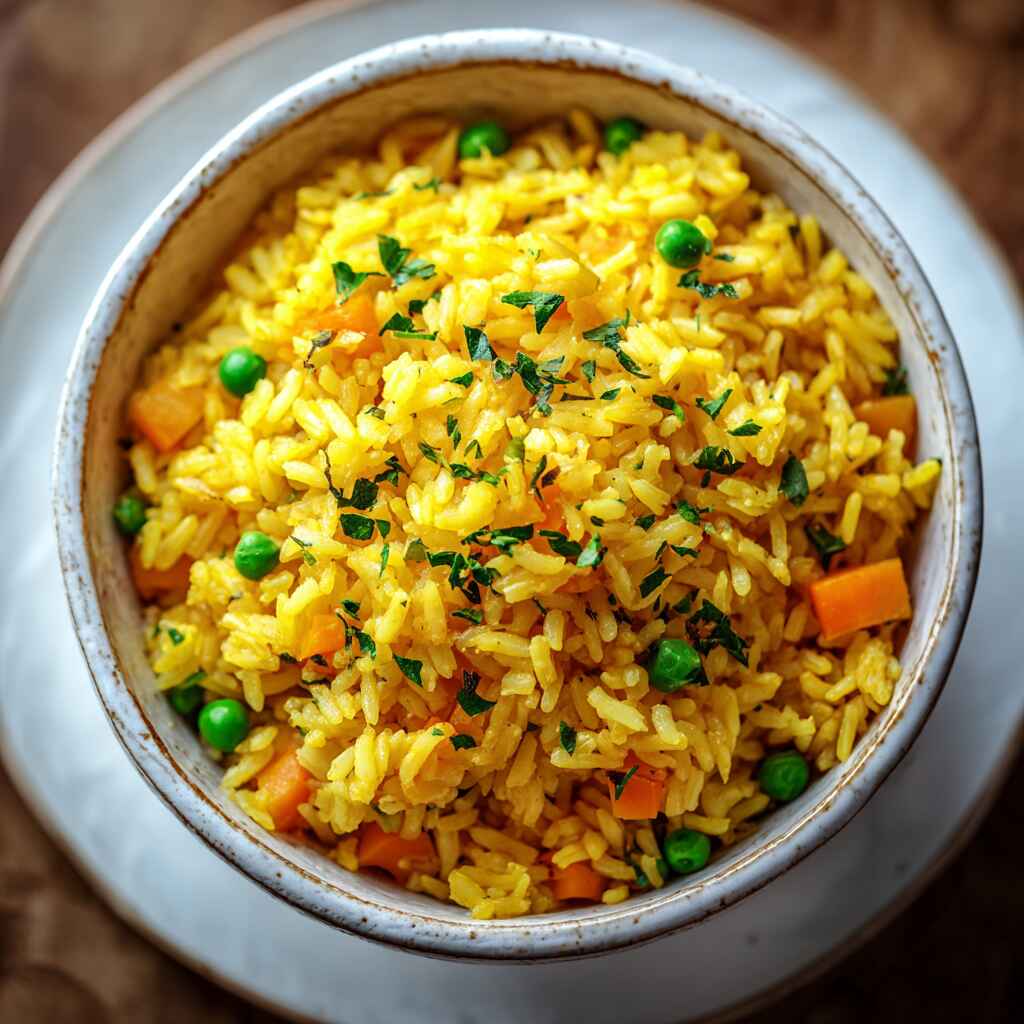Have you ever stood in your kitchen, staring at a pot of plain rice, wishing it could just taste like something anything more exciting? You’re not alone. We’ve all settled for bland bowls when we were too tired, too busy, or just didn’t know better. But what if your rice could be the highlight of your plate, not the afterthought? That’s exactly what this Rice Pilaf delivers. It’s warm, fragrant, and surprisingly easy to make with pantry staples. In my kitchen, pilaf became the dish that turned ordinary dinners into moments worth remembering. Let me show you how it changed everything.
I Gave Up on Fancy Rice – Until This Pilaf Brought Me Back”
I used to think rice needed to be dressed up in ten different spices or cooked in an elaborate broth to be flavorful. I’d scroll through recipe after recipe, only to land on a dish that either took forever or turned out mushy. One winter evening, snow tapping at the window, I gave up and threw whatever I had into a saucepan basmati rice, a bit of onion, a cube of veggie broth, and a spoonful of olive oil. Thirty minutes later, the aroma was hypnotic, and that first bite? Light, nutty, and comforting like a warm scarf on a cold day.
That dish my first Rice Pilaf reminded me of the stories my grandmother would tell over the stove in our tiny apartment in Queens. Born in Delhi, she brought with her recipes that didn’t need wealth, just care and timing. She believed food should be “soft to chew, but strong in memory.” Her pilaf had raisins, sometimes almonds, and always love. I never understood the emotional power of simple food until I made that pot. I think that’s why I’m sharing this now with you.
What makes Rice Pilaf stand out is how it absorbs flavor, unlike steamed rice that just carries sauce. The sautéed aromatics, the toasty grains, the cozy broth it all mingles into something special. If you’ve been disappointed before by sticky rice or dull flavor, this will change things.
Why This Rice Pilaf Works Every Time (Even When You’re Tired)
Some nights, you barely have the energy to decide what’s for dinner, let alone cook it. That’s exactly when Rice Pilaf steps in not just as an easy fix, but as a dish that feels like you tried harder than you actually did. The beauty of this pilaf lies in its quiet simplicity. Every grain of rice is gently toasted before the broth is added, giving it a slightly nutty aroma and preventing it from turning soggy. That tiny step is where the magic begins.
Instead of just absorbing flavor from the outside like boiled rice, pilaf locks it in at every level. The aromatics like sautéed onion, garlic, or even a cinnamon stick build a savory foundation. When simmered with broth, the rice swells slowly, soaking up every bit of warmth and spice without clumping together.
Here’s the part I never skip: letting the rice rest, covered, after cooking. It’s like a quiet moment before serving, and it helps finish cooking the grains without over-softening. Every bite comes out tender, distinct, and rich never mushy.
You could pair this pilaf with something hearty like Peanut Butter Chicken, or keep it light and serve it beside roasted vegetables or a chopped cucumber salad. The point is, it’s flexible. And when a dish gives you options, that’s when it truly becomes a weeknight hero.
When I served it with Chicken and Rice Soup during flu season, it wasn’t just a meal it felt like medicine. Warm, satisfying, familiar. And that’s what keeps me coming back to it week after week.
Rice Pilaf doesn’t need fancy spices or hours in the kitchen. It just needs a few good steps and a little heart.
Ingredients, Swaps & Foolproof Steps to Perfect Rice Pilaf”
What makes this Rice Pilaf recipe work so well is that it’s both forgiving and flavorful. You can swap, skip, or stretch almost every ingredient, yet still get a result that tastes rich and satisfying. That’s rare, especially when you’re trying to make something quick and memorable.
Ingredients You’ll Need:
- 1 cup long-grain basmati rice (or jasmine)
- 2 tablespoons olive oil or ghee
- 1 small yellow onion, finely chopped
- 2 cloves garlic, minced
- 2 cups vegetable broth (low-sodium preferred)
- 1/2 teaspoon salt
- 1/4 teaspoon ground cinnamon (optional, but warming)
- 1 bay leaf
- 1/4 cup chopped parsley (for garnish)
- 2 tablespoons toasted slivered almonds or raisins (optional, for texture)
Substitutions & Smart Swaps
- No basmati? Use jasmine or long-grain white rice but avoid short-grain rice, which gets sticky.
- Out of olive oil? Try avocado oil or unsalted butter for richness.
- Want more protein? Toss in chickpeas or shredded rotisserie chicken at the end.
- Add warmth with a pinch of turmeric, or brightness with lemon zest.
Common Mistakes to Avoid
- Don’t skip toasting the rice it keeps the texture light and fluffy.
- Avoid over-stirring once the liquid is added; it can break the grains.
- Don’t lift the lid during resting steam is key to final tenderness.
Pro Tips
- Use a heavy-bottomed saucepan to prevent uneven heat.
- Rinse rice until water runs clear to remove excess starch.
- Rest for 10 minutes before fluffing with a fork.
Ingredients & Substitutions Table
| Ingredient | Substitute Option |
|---|---|
| Basmati rice | Jasmine or long-grain white rice |
| Olive oil | Ghee, butter, or avocado oil |
| Vegetable broth | Chicken broth or mushroom broth |
| Onion | Shallots or leeks |
| Garlic | Garlic powder (1/2 tsp) |
Nutrition Highlights
| Nutrient | Per Serving |
|---|---|
| Protein | 7g |
| Carbs | 42g |
| Fat | 6g |
Step-by-Step Instructions
- Rinse the Rice
Place rice in a bowl and rinse under cool water until it runs clear. Drain well. - Toast the Aromatics
In a medium saucepan, heat olive oil. Add chopped onion and sauté until translucent. Stir in garlic and rice, cooking for 2–3 minutes until rice smells nutty. - Simmer to Perfection
Pour in broth, add salt, cinnamon, and bay leaf. Stir once, bring to a boil, then reduce to low. Cover and simmer for 15–18 minutes. - Let It Rest
Turn off heat. Without lifting the lid, let the pot sit for 10 minutes. Then fluff gently with a fork. - Garnish and Serve
Top with chopped parsley and toasted almonds or raisins if desired.
Try pairing it with something creamy like Cottage Cheese Mac and Cheese to balance the spice and texture of your pilaf.
Serving It with Love, Saving It for Later
How to Serve Rice Pilaf
This Rice Pilaf is more than a side dish it’s the kind of comfort food that can anchor an entire meal. You can spoon it beside roasted vegetables, tuck it under grilled chicken, or even stuff it into bell peppers for a satisfying vegetarian entrée.
For a cozy weeknight dinner, I love pairing it with a bowl of One-Pot Ground Beef Stroganoff. The creamy sauce melts into the pilaf, soaking into every bite. When I’m cooking for friends, I’ll plate it with lemon wedges and fresh herbs to brighten the table.
Make it your own add a dollop of yogurt on top or a handful of toasted pine nuts. However you serve it, make it personal.
How to Store
Let the rice cool completely before storing. Transfer it to an airtight container and refrigerate. It stays fresh for up to 4 days.
To reheat, add a splash of broth or water and microwave in 30-second bursts, covered loosely with a lid or towel. It’ll fluff up just like it did on day one.
Can You Freeze Rice Pilaf?
Yes ,and it freezes beautifully. Just be sure the pilaf is completely cooled first. Place in a freezer-safe container or bag, pressing out extra air. Label with the date.
It keeps well for up to 2 months. To reheat, thaw overnight in the fridge, then warm on the stove with a bit of added broth. You’ll get that just-cooked feel again.
When I froze a batch before a long trip, I remember coming home, jet-lagged and cold, to find that warm pilaf waiting in the freezer. Heated, fluffed, and garnished with herbs it brought me back to life.
Serve it alongside a fresh dish like No-Cook Lemon Ricotta Pasta for a light and balanced meal that’s dinner-party worthy even if it started in the freezer.
FAQS:
What’s the difference between rice pilaf and white rice?
The main difference is how they’re cooked and flavored. White rice is often boiled in plain water, while rice pilaf is first toasted in oil with aromatics like onions or garlic, then simmered in broth. This adds depth, a slightly nutty flavor, and a fluffier texture making it feel more like a dish than a side.
What is rice pilaf made of?
At its heart, rice pilaf is made of long-grain rice, oil or butter, onion, garlic, and broth. From there, you can add warm spices, herbs, nuts, or even dried fruit. It’s versatile and forgiving. My version keeps things simple yet soulful, using just a few staples to build big flavor.
Is rice pilaf healthier than mashed potatoes?
Yes, in many ways. Rice pilaf, especially when made with olive oil and vegetable broth, is lighter in fat and calories compared to mashed potatoes, which often contain heavy cream and butter. Plus, pilaf is easier to digest and holds up well for meal prep without becoming dense.
What goes with rice pilaf for dinner?
Rice pilaf pairs beautifully with almost everything from grilled chicken to creamy stews. I love serving it with roasted vegetables, yogurt sauces, or hearty mains like Peanut Butter Chicken. It’s neutral yet flavorful, making it the perfect companion on any plate.
CONCLUSION
Rice Pilaf isn’t just food it’s memory, comfort, and a quiet celebration of everyday cooking. It doesn’t shout. It doesn’t need to. One spoonful delivers warmth, tradition, and satisfaction. Whether you’re feeding your family, prepping for a cozy solo night, or bringing a dish to share, this pilaf always shows up just right.
If this recipe reminds you of someone you love, share it with them. Your memories keep recipes alive.
YOU MAY ALSO LIKE
- Cottage Cheese Cinnamon Muffins
- French Onion Dip with Greek Yogurt
- Apple Cinnamon Cottage Cheese Muffins
Rice Pilaf
Ingredients
Equipment
Method
- Rinse rice under cool water until water runs clear. Drain well.
- Heat olive oil in a saucepan. Sauté onion until translucent. Add garlic and rice, cook 2–3 minutes.
- Add broth, salt, cinnamon, and bay leaf. Stir once. Bring to a boil, then simmer covered for 15–18 minutes.
- Turn off heat and let rice rest, covered, for 10 minutes.
- Fluff with fork. Garnish with parsley, almonds, or raisins. Serve warm.


